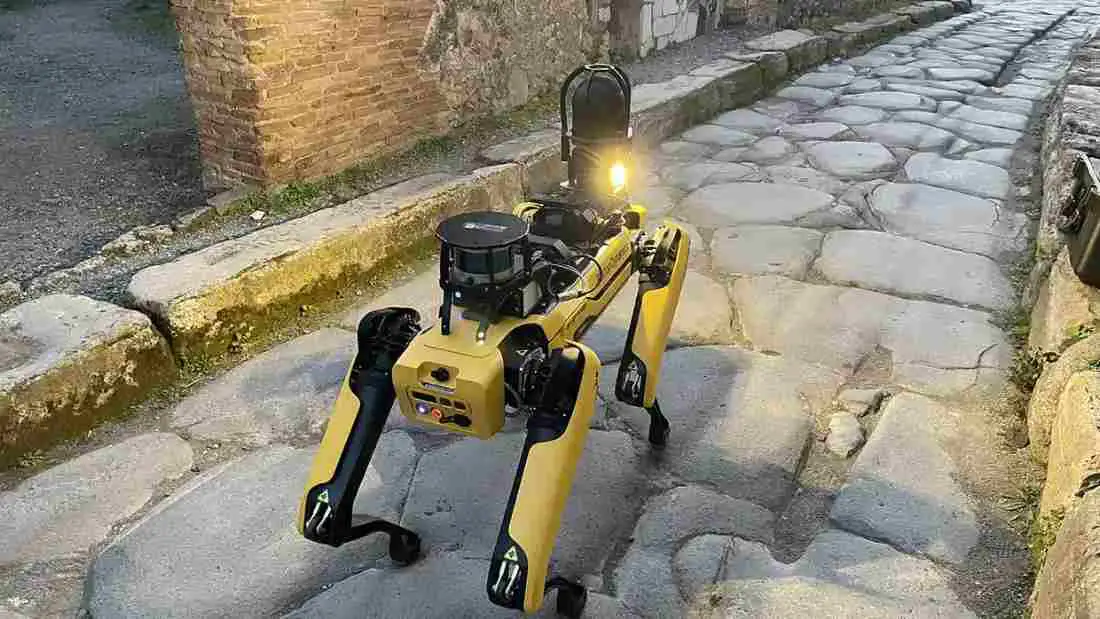In a world first, archaeologists in Pompeii have employed the help of a robot dog, named Spot, to patrol the ancient ruins. Spot is a Boston Dynamics creation and is the first of its kind to be used in archaeology. It stands about two feet tall and weighs around 30 pounds. It is equipped with cameras and sensors that allow it to autonomously explore the site, sending data and live images back to researchers.
Spot – the robot safeguarding Pompeii
Spot has been sent into ancient Pompeii’s ruins to find structural problems that require infrastructural support. The robot is also digging underground to investigate relics thieves’ tunnels, in Italy known as tombaroli. For years, grave robbers made a fortune by digging their way into the catacombs and stealing artefacts. These are then sold to art traffickers across the world. Since 2012, Italy’s art police have stepped up a crackdown on culture crime. However tunnels are still being discovered in and around Pompeii.
“Often the safety conditions within the tunnels dug by grave robbers are extremely precarious, and so the use of a robot could signify a breakthrough that would allow us to proceed with greater speed and in total safety.”
Gabriel Zuchtriegel, the director of Pompeii archaeological park.
The use of Spot the robot is part of a larger effort to preserve Pompeii for future generations. In the past, archaeologists have had to rely on manual labour to explore the site, which is time-consuming and dangerous. With Spot, they will be able to cover more ground in a shorter amount of time. Even more importantly, they will be able to do so without putting themselves at risk.
Spot’s mission is twofold. First to create a map of the site using its LiDAR scanner. Second to search for voids left by objects that have since decomposed. So far, it has been a success! In just a few weeks, Spot has already covered more ground than a team of archaeologists could in months. And it’s not just Spot that is helping to preserve Pompeii; other robots are being used as well.
Other robots in use in Pompeii
One such robot is an autopilot quadcopter equipped with a high-resolution camera. This drone is being used to create a three-dimensional model of the site. With this data, researchers will be able to plan future excavations with greater accuracy. Another robot, nicknamed “Mini-Tau,” is a ground-penetrating radar that is being used to map the underground tunnels of Pompeii.
“Technological advances in the world of robotics, in the form of artificial intelligence and autonomous systems, have produced solutions and innovations typically associated with the industrial and manufacturing world, but which until now had not found an application within archaeological sites due to the heterogeneity of environmental conditions, and the size of the site.”
Gabriel Zuchtriegel, the director of Pompeii archaeological park.
The park’s goal is to assess the site and develop a master plan that will guide future development. Researchers have also utilized a remote-controlled airplane equipped with a laser scanner capable of scanning the entire 66-hectare (163-acre) area in 3D. With this data, they will be able to create a digital model of the site that can be used to plan future excavations.
The use of robots in archaeology is not without its detractors, however. Some people argue that the use of robots takes the human element out of archaeology. What do you think? Let us know in the comments!
Disclosure: Please note that some of the links in this post are affiliate links. When you use one of my affiliate links, the company compensates me. At no additional cost to you, I’ll earn a commission, which helps me run this blog and keep my in-depth content free of charge for all my readers.


